First, I needed to figure out the scale in the picture above. The white line shows Luffy's height, which I assumed to be the average male height in Japan. Using this, I found the distance his arms stretched (red) and the diameter of the sphere (blue). From this, we can calculate that the sphere has a volume of about 1500 cubic meters. The density of gold is about 19 grams per cubic centimeter, so the sphere weighs 29 million kilograms.
Supposing Luffy's arms follow Hooke's Law (the basic spring force), we can use the weight to find the spring constant. Setting the weight of the sphere equal to the Hooke's Law force gives a spring constant of 10 million Newtons per meter. For comparison, the spring constant for the front suspension of a Triumph sports car is about 35,000 Newtons per meter.
Of course, using Hooke's Law is an approximation, since rubber has some unusual stretching properties. The polymers that make up rubber are best modeled with statistical mechanics, where temperature and entropy play significant roles. If you're interested, this is a nice explanation.



